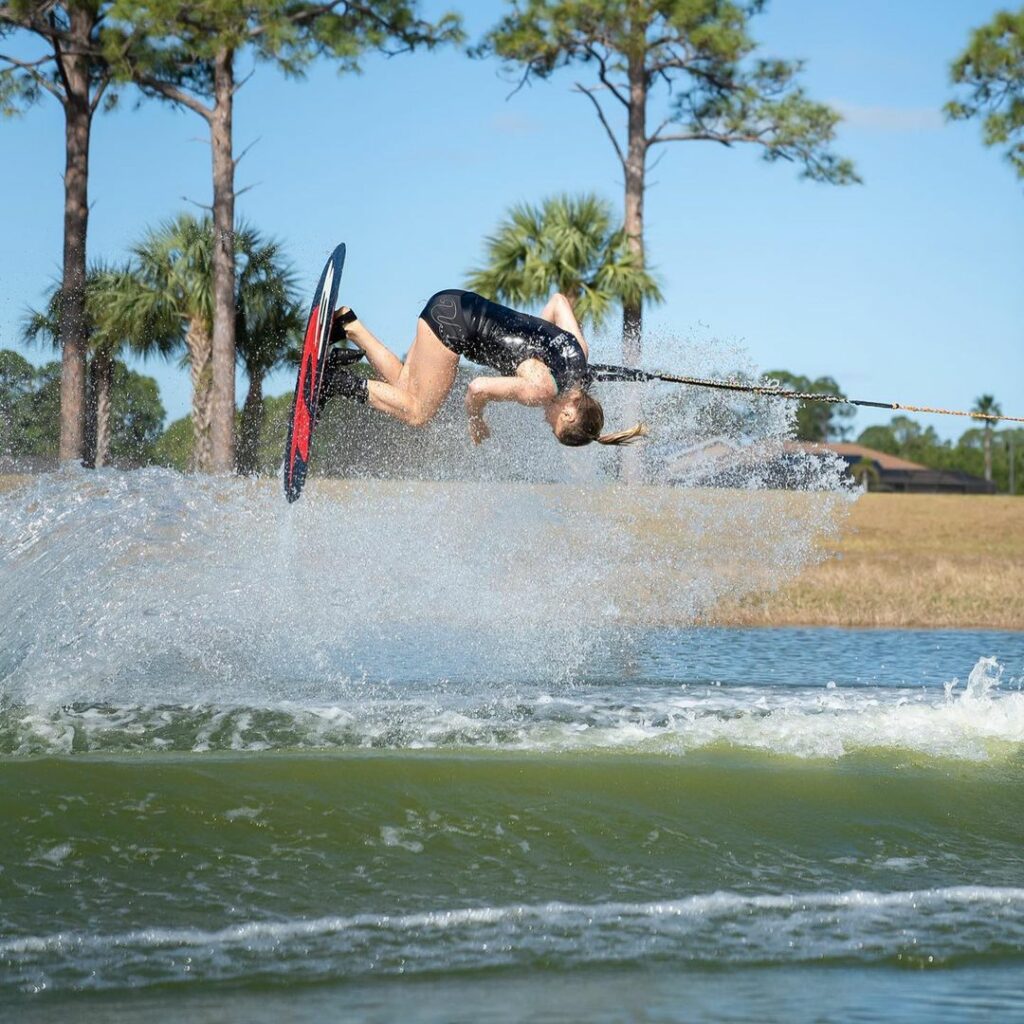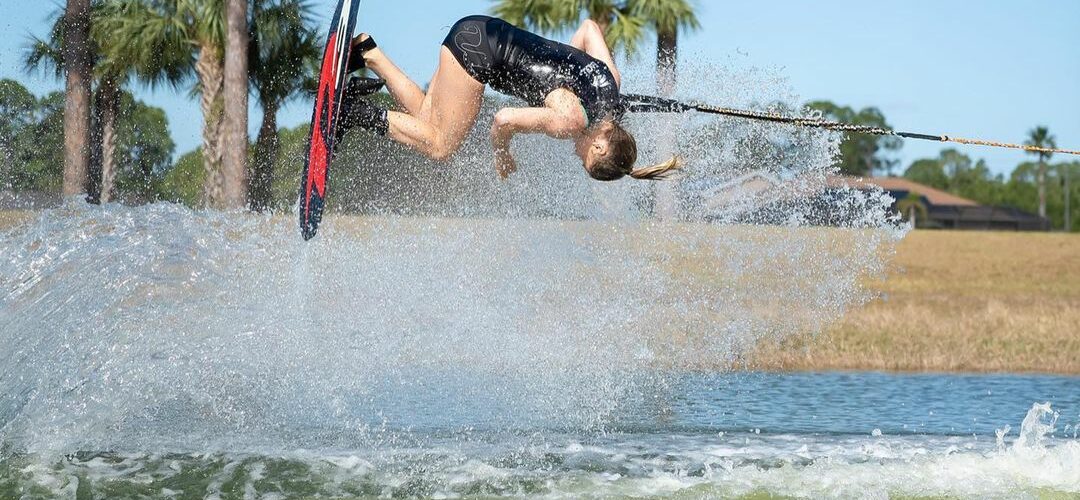How much is a trick worth?
As the World Championships near, trick skiing faces a quiet reckoning

Trick skiers, like world record holder Erika Lang, have redefined what was though possible in the sport (image: @erikalang36)
By Jack Burden
As the World Championships approach, a quiet but consequential debate is coming to a head: how much is a trick really worth?
At stake is the very structure of trick skiing’s scoring system—a rigid points table that hasn’t fundamentally changed in more than two decades. For athletes like world record holder Joel Poland, that’s no longer acceptable.
“The point values for high-difficulty flips are crippling trick skiing,” Poland told the IWWF Water Ski Council. “It’s limiting what athletes can do.”
Poland should know. Two of his most innovative tricks—the 900-point “UFO” and the 950-point “Matrix”—were recently approved for competition but, in his own words, are “tricks you’ll never see in a tournament” unless something changes. He’s not alone in that sentiment.
A Broken Balance
Trick skiing is unique among board sports: every maneuver has a fixed value, from 40-point surface turns to 950-point flips. The goal is objective scoring. The result? Homogeny.
“Right now the trick point values reward doing more tricks versus doing harder tricks,” said Brooks Wilson on the GrabMatters podcast. “You can get more tricks in because you’re going fast. It’s a speed game.”
That tradeoff—efficiency over difficulty—has shaped elite competition. Instead of variety, most skiers now converge on the same sequence of reliable, high-value tricks.
“We want to see variation,” added Freddie Winter. “Instead, everyone’s forced to do the same kind of runs.”
The Repetition Problem
An analysis of over 100 score sheets at the 2023 World Championships shows just how narrow the tricking landscape has become.
Among hand tricks, backflips dominate. The half twist (BFLB), worth 750 points, appeared in every finalist’s run—typically paired with its reverse. In contrast, the only other trick worth 750, the ski-line seven back, was attempted just once.
The mobe (BFLBB), worth 800 points, was nearly as common, performed by three-quarters of the finalists—far outpacing other tricks in its point range. The basic backflip remains a staple, especially among intermediate-level skiers, tricks worth comparable points, such as W7B, SLBB, and SL5s, were attempted much less often and with much lower success.
Toe tricks show a similar pattern. Toe back-to-backs (TBB) are ubiquitous, appearing in 112 of 117 toe runs (the exceptions were early falls). Toe wake back-to-backs were also incredibly common; the regular and its reverse featured in every single finalist’s toe run. Toe wake tricks worth comparable points, such as TWO or TWLB, were less common, although some of this stems from them not having an easy reverse.
Misaligned Incentives
Not all frequently performed tricks are necessarily overvalued—some, like backflips, may be common because they serve as foundational building blocks for higher-scoring flips. And in toe runs, the inherent physical limitations naturally result in a narrower pool of viable tricks and sequences.
But some mismatches are hard to ignore. Why does the toe wake back-to-back (TWBB) score more than the toe wake 360 (TWO), despite similar difficulty? Why is the mobe front-to-front, attempted only three times at the tournament, valued the same as the standard mobe, which was performed over 100 times?
Take the half cab (BFLF) as another example. Worth 550 points, it was performed just once for every three half twists (BFLB), valued at 750. While it may be true that landing in the back is more difficult than taking off in the back, does that justify a 200-point gap? If so, why are half twists so common—and half cabs so rare?
Innovation Without Reward
In early 2024, the IWWF approved four new flips, including Clarens Lavau’s “Super Half Twist” and Poland’s “UFO.” But even with official approval, no one expects them to appear in major tournaments.
Poland’s “Matrix”—a frontflip with a ski-line 540 from the back position—was awarded 950 points. That’s just 150 more than a basic frontflip, and identical in value to the established super-mobe-five.
“There’s a point where you go, well, the slam it takes to learn this trick is just not going to be worth the extra 50 points,” said Poland. “I was trying to do a super-mobe-seven—a backflip 720 over the rope—but there’s not much point because they’ve made it very clear no trick can be worth more than 1,000 points.”
The scoring ceiling isn’t just discouraging; it’s actively stifling innovation.
“I tried three of them,” Poland added, “and they were the worst crashes of my life. I was like, ‘I’m never gonna try that again.’”
Without a meaningful scoring incentive, tricks like the Matrix may never make it into competition. Even Poland, one of the sport’s most creative skiers, is reconsidering the cost.
“You’re limiting creativity and progression,” said Winter. “Do we want to see the same runs forever—just a bit faster?”
A System Stuck in Neutral
The IWWF knows the problem exists. In a memo last year, Council Chair Candido Moz urged the Tricks Working Group to bring forward point values that better reflect “true difficulty levels.”
But attempts at reform have stalled for years.
“The skiers could never agree on point values,” Moz has explained. “So IWWF never received a proposal.”
That may change this September. A restructured Tricks Working Group, which includes Poland as a member, is expected to present formal recommendations during the World Championships in Recetto.
Time for a Reset?
Poland is done waiting. “In my opinion, [the current system] is crippling trick and limiting the athletes,” he said. He plans to stay vocal in the lead-up to Recetto.
Winter sees trick skiing as the discipline with the most untapped potential. “Right now, it’s just not reaching it,” he said. “But it could.”
The current system rewards repetition and safety. A modernized score table—one that truly values difficulty and risk—could transform the sport overnight.
“You’ve got to blow it up to build it up,” said Wilson.
The World Championships run August 27–31 in Recetto, Italy. A formal review of trick point proposals is expected to take place at the IWWF Water Ski Council meeting during the event.

